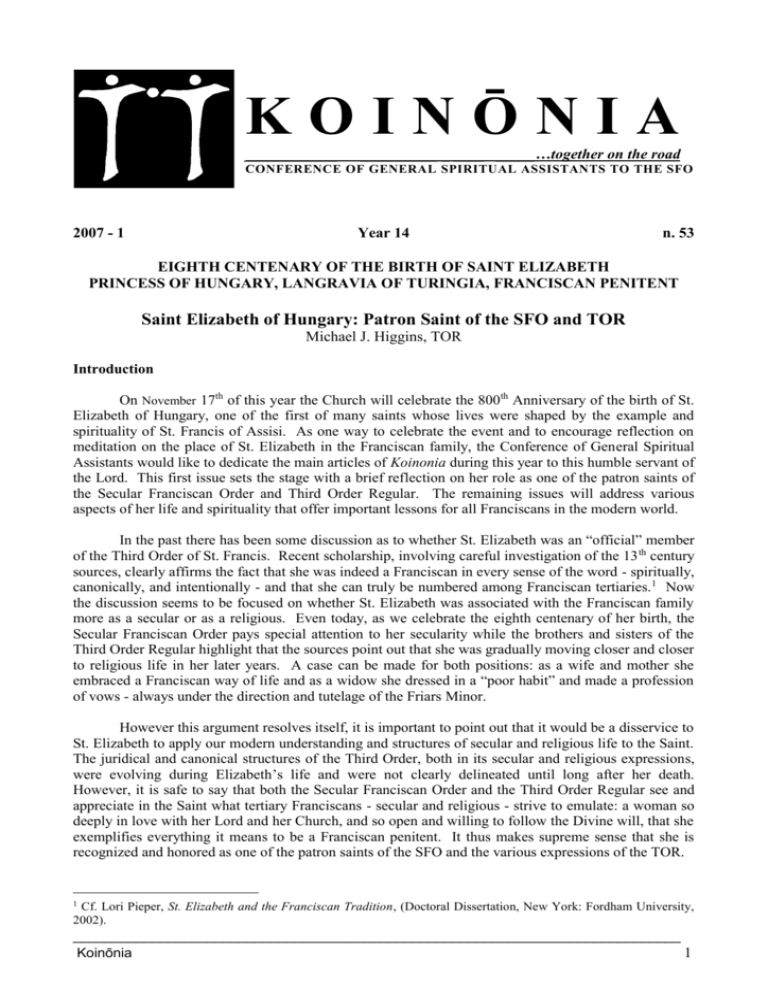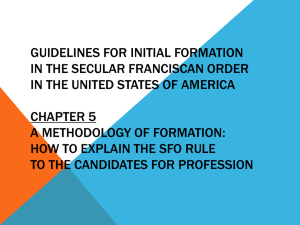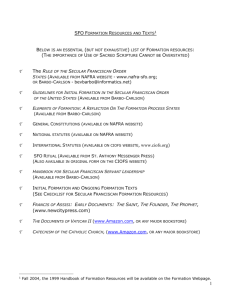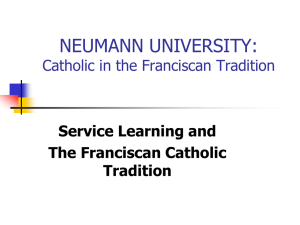K O I N Ō N I A ______ ______ _ ____ _____…together on the road
advertisement

KOINŌNIA ____________ __________ _ ____ _____…together on the road CONFERENCE OF GENERAL SPIRITUAL ASSISTANTS TO THE SFO 2007 - 1 Year 14 n. 53 EIGHTH CENTENARY OF THE BIRTH OF SAINT ELIZABETH PRINCESS OF HUNGARY, LANGRAVIA OF TURINGIA, FRANCISCAN PENITENT Saint Elizabeth of Hungary: Patron Saint of the SFO and TOR Michael J. Higgins, TOR Introduction On November 17th of this year the Church will celebrate the 800th Anniversary of the birth of St. Elizabeth of Hungary, one of the first of many saints whose lives were shaped by the example and spirituality of St. Francis of Assisi. As one way to celebrate the event and to encourage reflection on meditation on the place of St. Elizabeth in the Franciscan family, the Conference of General Spiritual Assistants would like to dedicate the main articles of Koinonia during this year to this humble servant of the Lord. This first issue sets the stage with a brief reflection on her role as one of the patron saints of the Secular Franciscan Order and Third Order Regular. The remaining issues will address various aspects of her life and spirituality that offer important lessons for all Franciscans in the modern world. In the past there has been some discussion as to whether St. Elizabeth was an “official” member of the Third Order of St. Francis. Recent scholarship, involving careful investigation of the 13 th century sources, clearly affirms the fact that she was indeed a Franciscan in every sense of the word - spiritually, canonically, and intentionally - and that she can truly be numbered among Franciscan tertiaries.1 Now the discussion seems to be focused on whether St. Elizabeth was associated with the Franciscan family more as a secular or as a religious. Even today, as we celebrate the eighth centenary of her birth, the Secular Franciscan Order pays special attention to her secularity while the brothers and sisters of the Third Order Regular highlight that the sources point out that she was gradually moving closer and closer to religious life in her later years. A case can be made for both positions: as a wife and mother she embraced a Franciscan way of life and as a widow she dressed in a “poor habit” and made a profession of vows - always under the direction and tutelage of the Friars Minor. However this argument resolves itself, it is important to point out that it would be a disservice to St. Elizabeth to apply our modern understanding and structures of secular and religious life to the Saint. The juridical and canonical structures of the Third Order, both in its secular and religious expressions, were evolving during Elizabeth’s life and were not clearly delineated until long after her death. However, it is safe to say that both the Secular Franciscan Order and the Third Order Regular see and appreciate in the Saint what tertiary Franciscans - secular and religious - strive to emulate: a woman so deeply in love with her Lord and her Church, and so open and willing to follow the Divine will, that she exemplifies everything it means to be a Franciscan penitent. It thus makes supreme sense that she is recognized and honored as one of the patron saints of the SFO and the various expressions of the TOR. 1 Cf. Lori Pieper, St. Elizabeth and the Franciscan Tradition, (Doctoral Dissertation, New York: Fordham University, 2002). _____________________________________________________________________________ Koinōnia 1 Patron Saints The Catechism of the Catholic Church makes it very clear that the dogma of the Communion of Saints is an essential aspect of our Catholic faith. Referring to this belief it states: The witnesses who have preceded us into the kingdom, especially those whom the Church recognizes as saints, share in the living tradition of prayer by the example of their lives, the transmission of their writings, and their prayer today. They contemplate God, praise him and constantly care for those whom they have left on earth. When they entered into the joy of their Master, they were “put in charge of many things.” Their intercession is their most exalted service to God’s plan. We can and should ask them to intercede for us and for the whole world.2 Among the “many things”3 that this paragraph mentions that the saints are asked to do is to “contemplate God, praise him and constantly care for those they have left on earth.” The Catechism also points out that they are examples of faith, intercessors before God, and protectors of the faithful. It is in these roles that they are justifiably referred to as “patron saints.” After all, “their intercession is their most exalted service to God’s plan.” The concept of patron saints is founded on the dogma of the Communion of Saints and on the Pauline doctrine of the Mystical Body of Christ. Individual patron saints are those who “through ancient tradition or through legitimate election are venerated with a particular cult by the clergy and people of a location, as special protectors and advocates before God.”4 Bugini points out that the first mention of patron saints dates back to a text from the second century in which Sts. Peter and Paul are referred to as “great patrons… and friends of our Lord Jesus Christ.” 5 The author also points out that Pope Leo I (440-461) invoked their intercession along with that of St. Lawrence, another famous martyr, as he struggled to save Rome from the onslaught of Attila the Hun in 452 and that by the end of the 6th century the two saints were revered as the patron saints and special protectors of the city. By this time the collection of the relics of many saints and the custom of setting aside special days to remember their examples and request their aid and intercession was also widespread. Through the years various saints have been revered as having a special connection or importance for specific churches, cities or towns, occupations, and just about any human interest.6 The more well-known Franciscan patron saints include St. Francis who, among other things, is universally revered as the patron saint of the environment; St. Clare who has the dubious honor of being the patron saint of television; and, St. Anthony who is constantly invoked as the patron saint of those who are in search of lost articles. Even St. Francis recognized the importance of patron saints and placed his Order under the protection of the Blessed Virgin Mary. Celano points out that the Saint, embraced the Mother of Jesus with inexpressible love, since she made the Lord of Majesty a brother to us. He honored her with his own Praises, poured out prayers to her, and offered her his love in a way that no human tongue can express. But what gives us greatest joy is that he appointed her the Advocate of the Order, and placed under her 2 Catechism of the Catholic Church, 2nd edition (1997), paragraph 2863 available from the Vatican web site at http://www.vatican.va/archive/catechism/p4s1c2a3.htm. 3 The Catechism here references Mt 25:21 and the parable of the talents in which a master praises his faithful servant by stating, “Well done, my good and faithful servant. Since you were faithful in small matters, I will give you great responsibilities.” 4 Annibale Bugini, “Patrono,” in Enciclopedia Cattolica, vol. IX, (Città del Vaticano: Casa Editrice G.C. Sansoni, Firenze, 1952), p. 983. 5 Ibid. p. 983. Bugini here references the text Passio sanctorum Petri et Pauli (Passion of Saints Peter and Paul) a pious account of the martyrdom of the two saints attributed to Pseudo-Marcellus. 6 Cf. the “Patron Saints Index” at http://www.catholic-forum.com/saints/patron00.htm for a detailed list of patron saints in English. _____________________________________________________________________________ Koinōnia 2 wings the sons he left behind, that she might protect and cherish them to the end. (2C 198) Following the example of St. Francis, the Blessed Virgin Mary maintains a special place of honor and reverence in the Franciscan family and is revered as its principle Advocate and Patron. St. Louis and St. Elizabeth: Patron Saints of the SFO and TOR In addition to Our Lady, the Secular Franciscan Order and Third Order Regular look to and honor St. Louis of France and St. Elizabeth of Hungary as their special patrons. The first chapter of the TOR Constitutions is found under Title I, “Our Identity,” and is entitled “The Charism of the Third Order Regular of Saint Francis.” It recognizes that the Order finds its “historical and spiritual origins in the ancient Order of Penance, the penitential movements and in Saint Francis of Assisi” (Art. 1) and also points out that it is “united in a special way with the other institutes which profess the same Rule as well as with the Secular Franciscan Order” (Art. 5). The chapter concludes by stating that, the “Third Order Regular of Saint Francis is placed under the protection of the Immaculate Virgin Mary, its heavenly patron. The friars also venerate as their patrons, Saint Louis, King of France, and Saint Elizabeth of Hungary” (Art. 6). The Ritual of the SFO highlights a similar reverence to the Saints in the section entitled “Profession in the Secular Franciscan Order: Within the Mass.” Section 20 points out that when the profession to the SFO is made as part of a Eucharistic celebration, “the Mass formula to be used may correspond to the liturgy of the day; or, if the rubrics permit, the votive Mass of St. Francis or of St. Louis King or St. Elizabeth of Hungary may also be chosen.” The reverence that both the SFO and TOR give to St. Louis and St. Elizabeth as patron saints dates back many centuries. In this the two Orders follow Bugini’s insight that “through ancient tradition or through legitimate election” the saints have been “venerated with a particular cult” by the brothers and sisters of the Secular Franciscan Order and the Third Order Regular and honored as their “special protectors and advocates before God.” It is safe to say that the tradition of honoring both St. Louis and St. Elizabeth by Franciscan tertiaries has been an integral part of the fabric of the mentality and self understanding of the Third Order from the time that the Saints were canonized. St. Elizabeth was canonized by Pope Gregory IX on May 27, 1235, in the Church of Dominic in Perugia.7 It is interesting to note that she was third person associated with the Franciscan movement to be canonized by this pontiff - St. Francis was canonized by Gregory IX in in 1228 and St. Anthony of Padua was canonized in 1232. Her cult rapidly took root in the Franciscan family and she was readily received by the Third Order as one of its own. For his part, St. Louis was recognized and honored by Franciscans even before his death. It is doubtful that he was a member of the Third Order of St. Francis, but his love and support of the Franciscan family - and other mendicant groups, including the Dominicans - is unquestioned. In recognition of their deep respect for the King, and in recognition for all that he had done for the Order, the Friars Minor considered him to be an honorary member. In recognition of this, during the General Chapter at Narbonne in 1260 St. Bonaventure proposed that suffrages for the King be celebrated by the Order on a yearly basis. The proposal was approved by the Order at the General Chapter of 1263 in Padua.8 During this whole process Louis was still alive! St. Louis died in 1270 and was canonized on August 11, 1297. The only other people to receive a similar honor in the 13th century from the Friars Minor - after their deaths - were Popes, including Innocent III, Gregory IX, Alexander IV, Martin IV, Nicholas III, and Nicholas IV. The importance that the two saints enjoyed in the Third Order - and in the whole Franciscan family - can also be found in the loving way they have been portrayed in art, celebrated in prayer, 7 The text of the Papal Bull of canonization, Gloriosus in Maiestate, can be found in Lino Temperini, Santa Elisabetta d’Ungheria secondo le fonti storiche (Roma, Editrice Francescanum, 2006) pp. 78-81. 8 Cf. Gabriele Andreozzi, Elisabetta e Ludovico: I santi patroni del Terzo Ordine di San Francisco (Roma, Editrice Francescanum, 1996), p. 60. _____________________________________________________________________________ Koinōnia 3 honored in song and story, and included in the official legislation of the Orders even in the early centuries of the Franciscan movement. It beyond the scope of this short reflection to give a complete list of all these references, the following are presented as examples of this vast material: • • • • • • • • • The Breviary of the Roman Curia was adopted by the Friars Minor in 1223 and became the official prayer of the Order by 1230. During the next 70 years the Order introduced only 5 saints to the calendar of saints listed in this breviary: St. Francis, St. Anthony of Padua, St. Elizabeth, St. Clare, and St. Louis.9 Simone Martini (1284-1344) portrays St. Elizabeth standing next to St. Clare10 and St. Louis standing opposite of St. Francis and next to St. Louis of Toulouse11 in the Lower Basilica of St. Francis. It is interesting to point out that St. Louis of Toulouse was a nephew of St Louis and of Mary of Hungary whose great-aunt was Saint Elizabeth. In 1495 the Renaissance artist Filippino Lippi (1457 - 1504) left an unfinished painting of St. Francis handing St. Louis and St. Elizabeth copies of the Rule of the Third Order.12 By the early 15th century Franciscan breviaries and lectionaries contain the texts for the celebration of the feasts of St. Louis and St. Elizabeth.13 The first text of Constitutions of the Third Order Regular, which dates to 1475, directs the friars of the Order to celebrate Morning and Evening Prayer in honor of Sts. Peter and Paul, St. Francis, St. Louis, and St. Elizabeth.14 A calendar of saints for the Third Order published in Parma in 1648 specifically identify St. Louis and St. Elizabeth as patrons of the Order and state that their feast days are to be celebrated as first class (primae classis) feasts each with its proper octave.15 The Basilica of Sts. Cosmas and Damian in Rome, which has been the home of the Minister General and General Council of the Third Order Regular since the early part of the 16th century, hosts a series of frescoes that date to the middle of the 17th century honoring the male and female saints and blesseds of the Third Order. The procession of the lunettes of the male members concludes with a life-sized image of St. Louis and those of the female members conclude with one of St. Elizabeth. Misericors dei filius, the Rule given to the then Third Order Secular in 1883 by Pope Leo XIII, grants a plenary indulgence to members of the Order who go to Confession and receive the Eucharist on special days including the one honoring “Louis, King of the Gauls, the heavenly Patron of the members of the Third Order on the 25th day of August (and) of Elizabeth of Hungary on the 19th day of November”16 The legislation of the Third Order Regular and the Secular Franciscan Order make special mention of the Saints. St. Elizabeth of Hungary: Franciscan Penitent and Model of Faith The previous section of this reflection has deliberately dealt with both St. Louis and St. Elizabeth. This is entirely proper since the two saints have had such a long intertwined history with the Orders. However, it is also important to point out that St. Elizabeth stands out in her own right as a Franciscan penitent and as a saint who has a lot to teach us all about how to live a more vibrant Franciscan and spiritual life. Fulvio Rampazzo, “Lineamenti di liturgia francescana: Indagine storica sullo sviluppo del santorale francescano,” Laurentianum 40:3 (1999), p. 511. An English translation of this article can be found in “Fundamental Elements of Franciscan Liturgy: Inquiry on the Development of the Franciscan Calendar of Saints,” Greyfriar’s Review 14:3 (2000), pp. 277-294. 10 To view click on http://www.thais.com/speciali/assisi/SimoneMartini/hi_res/scheda_13.html. 11 To view click on http://www.thais.it/speciali/assisi/SimoneMartini/hi_res/scheda_12.html. 12 Cf. Lino Temperini, Frate Francesco: A Tutti i Suoi Fedeli, (Roma, Editrice Francescanum, 1987) cover design and explanation on p. 4. 13 Andreozzi, Elisabetta e Ludovico, pp. 60-66. 14 Ibid., p. 68. 15 Gabriele Andreozzi, Elisabetta e Ludovico, p. 70. 16 Misericors dei filius, The Index of Indulgences and Privileges: Chapter I, On Plenary Indulgences, VIII and IX. 9 _____________________________________________________________________________ Koinōnia 4 An attentive reading of the 13th century sources of the life of St. Elizabeth reveals her to be a woman who was always open to the will of God and always willing to follow it. In her childhood she was obedient to her family in Hungary and to her new family in Germany where she grew up with her future husband, Ludwig. As a married woman she was happy and willingly obedient to her marriage vows and to the loving relationship she had with her husband and her three children. It is also clear that she tried to be obedient to her spiritual director, Conrad, and to the friars whose example and teaching became ever more central in her life. After the death of her husband, her expulsion from her home, and the loss of her children she remained open and responsive to the Divine will and became even more prayerful and more devoted to the poor and sick. During the course of her whole short life she showed herself to be a penitent in the full sense of the word - that is, a person who much like Our Lady was always willing to freely and completely give her fiat to the Divine will and word of God, even in dark and confusing times. This portrait of St. Elizabeth is confirmed by Pope Gregory IX who, even though he never makes reference to her connection with the Franciscan family, presents her as a model of the penitential life. Andreozzi points out that in 1235 in a bull entitled Iesus Filius the Holy Father exalts the following penitential virtues of the saint: her love of penance, her spiritual poverty, her hatred of sin, her dedication to works of mercy, her love for justice and peace, and her patience in the face of hardship and suffering.17 He also states that, it is certain that Elizabeth, in her humility, believed herself to be nothing other than one of many people who, in the words of Gregory IX, “wish to prepare for eternal salvation by leaving worldly vanities by deciding to do penance with a contrite heart and a humble spirit” first in her own home and then elsewhere in service to the poor and sick… She demonstrates a love that is not closed in on itself, but one that is illuminated from above and open to humble people; to the hungry and the sick with whom she wished to be mother and sister while participating in their suffering and personally trying to alleviate it. She burnt herself out like a meteor at only 24 years of age - but she left an indelible memory. The Church proclaimed her virtue, the faithful ran to her tomb and obtained prodigious graces, the Friars Minor honored her along with St. Francis and St. Anthony, and the penitents venerated her as their example and patron.18 St. Elizabeth continues to inspire Franciscan men and women today by her example of prayer, ongoing conversion, humility, and poverty - the key virtues of the penitential life. The many letters, articles, books, and studies that the 8th centenary of her birth has inspired provide an eloquent testimony of her relevance to the world of the 21st century. This affirmation is echoed in a recent letter sent to all the brothers and sisters of the SFO by the Minister General of the Order, Encarnación del Pozo, and the members of the CIOFS Presidency. The life of our holy patroness and her Franciscan spirit provides an inspiring example for us to imitate. Elizabeth challenges us, by living our secular and Franciscan identity, to offer our lives, in response to the signs of our time, with a continuous spirit of conversion and moved to give an active response to the requirements of our Rule (4) to “go from Gospel to life and life to Gospel.” We are further challenged to create bonds of friendship and mutual understanding in a world filled with indifference and where the weak are often mistreated, so that the values of our own vocation may shine with a new light in our daily lives. We, your brothers and sisters of the CIOFS Presidency, invite you to share with us in celebrating the life of St. Elizabeth by deepening our 17 18 Andreozzi, Elisabetta e Ludovico, p. 20. Ibid., pp. 40-41. _____________________________________________________________________________ Koinōnia 5 understanding and appreciation for her and by engaging in a reflection on her life and spirituality.19 Conclusion A well respected Franciscan historian searched in vain to find an official document from the early centuries of the Franciscan movement in which St. Elizabeth and St. Louis are clearly identified as patron saints of the Third Order Regular and the Secular Franciscan Order. To his surprise the search turned up nothing and he declared that the saints were only accepted as patrons of the Orders at the middle of the 18th century.20 The missing element in this historian’s study is that popular devotion and reverence of saints are not often written down in official documents - they grow out of a sense of connection and a desire to emulate and honor. It is clear that for centuries both St. Elizabeth and St. Louis have been seen and appreciated by the brothers and sisters of the SFO and TOR as Saints who clearly manifest what the Franciscan tertiary life is all about. Both of them in their own way demonstrate the five elements of penance that St. Francis encouraged the penitents to embrace: love of God, love of neighbor, hatred of sin, reception of the Eucharist, and lives that produce “worthy fruits of penance” (1LtF 1-4). One would search in vain to find better examples of the Franciscan tertiary life or better patron saints! This article highlights the fact that St. Elizabeth has been an important figure in the Franciscan family since the early 13th century. Along with St. Louis she has been honored as a patron saint of the Secular Franciscan Order and Third Order Regular for hundreds of years. Her example and role as patron are as valid today as they ever were. Given the situation in the modern world, perhaps we need her intercession, protection, and witness of gentle love more than ever. My prayer is that this centenary year will usher in a renewed love and appreciation for this wonderful Franciscan woman. Father, you helped Elizabeth of Hungary to recognize and honor Christ in the poor of this world. Let her prayers help us to serve our brothers and sisters in time of trouble and need. We ask this through our Lord Jesus Christ, your Son, who lives and reigns with you and the Holy Spirit, one God, for ever and ever. Amen! NEWS - CHAPTERS - MEETINGS Argentina - Fraternal and Pastoral Visits and Chapters The Fraternal and Pastoral Visits for the SFO in Argentina took place from January 8-10, 2007, in the area of Saldán, Córdoba. Following the prepared program, the visitators, María Aparecida Crepaldi, OFS, International Councilor for the Portuguese language and Martín Bitzer, OFM Conv., General Spiritual Assistant, met with all the members of the National Council - except the National Minister who was hospitalized during the visitation. The Pastoral Visit opened after a cordial and fraternal welcome. Gerónimo Martina, OFM, National Spiritual Assistant, presented an overview of the situation of spiritual assistance to the SFO in Argentina. This was followed by a discussion with the other Spiritual Assistants and with the members of the National Council who were present. It was noted that it is sad that the spiritual and pastoral care of the SFO in Argentina is not among the priorities of the religious provinces in the country (OFM, OFM Conv., and OFM Cap.), However, in the name of CIOFS, the Visitators expressed a particular word of thanks to the Assistants who are dedicating their service to the SFO and to Luis Scozzina, OFM, one of the three OFM Ministers Provincial who are present in the country. The Fraternal Visit took place on the following day and the various registers of the fraternities were examined. Everything was in order. A discussion of the principal problems of the SFO both on the national level and on the level of the ten regions followed. After the Fraternal and Pastoral Visits the Visitators moved to San Antonio di Arredondo, Córdoba, for the celebration of the National Elective Chapter in the presence of some of the Spiritual Assistants and of Luis Scozzina, OFM, the Minister Provincial of the Province of “San Miguel Arcángel.” The maturity of the capitulars established an atmosphere in which the elections proceeded with great serenity and transparency. Silvia Noemí Diana, Letter sent to “All the brothers and sisters of the Secular Franciscan Order,” on the occasion of the Feast of the Epiphany, 2007; cf. http://www.ciofs.org/sfo.htm. 20 Servus Gieben, “I patroni dell’Ordine della penitenza,” Collectania Francescana 43:1-3 (1972), pp. 229-245. 19 _____________________________________________________________________________ Koinōnia 6 SFO, was elected as the National Minister. At the same time the National Fraternal Chapter was celebrated by the Seculars who were not participating in the elections. Antonio Saraceno, OFM Conv., Spiritual Assistant to the SFO, conducted the spiritual exercises for the Chapter. Assisi - Course for Spiritual Assistants to the SFO and YouFra in Italy The Course for Formation of Spiritual Assistants to the SFO and YouFra in Italy took place at the “Casa Leonori,” the headquarters of the Conference of the OFM Ministers Provincial in Italy in Santa Maria degli Angeli, Assisi, from January 22 - 26, 2007. The course was organized by the Conference of National Spiritual Assistants and, in addition to the four National Spiritual Assistants, over 80 Spiritual Assistants from various SFO and YouFra fraternities in Italy attended. The principal theme of the Course was: “The Assistant: Witness of Spirituality and Channel of Communion.” Two General Spiritual Assistants, Samy Irudaya, OFM Cap., and Ivan Matić, OFM, participated in the Course on January 24 and 25. Bishop Paolo Giulietti, who is responsible for the pastoral outreach to youth from the Conference of Italian Bishops, took part in the round-table discussion on the afternoon of January 24 on the theme of Franciscan Youth and was the first to talk. Ivan Matić, OFM, followed with a reflection on accompanying the Franciscan Youth from the point of the view of the Spiritual Assistants. Maura Murgia, the National President of the YouFra in Italy, presented an interesting letter addressed to the Spiritual Assistants on the importance of accompanying young Franciscans. An assembly of the Spiritual Assistants to YouFra took place in the evening in order to reflect on specific questions regarding the role and responsibilities of assistance to YouFra, the constitution of the Conference of National Assistants to YouFra, and other maters. The morning of January 25 was dedicated to group work. This was followed by a presentation of the Manual for Spiritual Assistants to the SFO and YouFra by Samy and Ivan - who gave special attention to Chapter IV, which deals with the theme: Spiritual and Pastoral Assistance to the SFO. Panama - National Elective Chapter The National Elective Chapter in Panama took place from January 26-28, 2007. Thirty-five capitulars participated in a very fraternal atmosphere. Ligorio Antonio Dussan, SFO, the International Councilor from Colombia, was present at the Chapter as the delegate of the Minister General. Víctor Hugo Chacón Solano, OFM, from Costa Rica, represented the Conference of General Spiritual Assistants. Some reflection during the Chapter was given to the Rule of the SFO, to the celebration of the Franciscan charism, and to the 8th Centenary of the birth of St. Elizabeth. Juan Manuel Pinzón de León, SFO, from the Fraternity of St. Bernardine of Siena, in the city of David, Chiriquí Province, was elected as National Minister. Rome - CIOFS Presidency and Blessing of the CIOFS Headquarters The CIOFS Presidency met in Rome from February 17 - 24, 2007, at a retreat house run by the Suore Francescane Angeline. The topics for the meeting included planning for the General Chapter that will be held in Hungary in 2008, discussion of the work of the commissions, the relationship between the Secular Franciscan Order and Franciscans International, the first international assembly of YouFra that will be held in Barcelona in June and July of this year, the finances of the Order, and a number of juridical and scheduling items. Lori Pieper, SFO, conducted a period of ongoing formation for the Presidency and presented a paper on the spirituality of St. Elizabeth of Hungary on Thursday, February 22. The next meeting of the Presidency will be held in Assisi in November so as to allow the members to participate in the official closing of the 800th Anniversary Year of the birth of St. Elizabeth. During the meeting of the CIOFS Presidency the members celebrated the official blessing of the CIOFS Headquarters on Via Vittorio Puti in Rome. The Secretary of the Congregation of the Institutes of Consecrated Life and Societies of Apostolic Life, Archbishop Gianfranco Gardin, OFM Conv., conducted the blessing. The other Franciscan Orders were represented by the Minister General of the Capuchins, Mauro Jöhri, OFM Cap; the Vicar General of the Friars Minor, Francesco Bravi, OFM; and the Vicar General of the Third Order Regular, Michael J. Higgins, TOR. The Minister General, Encarnacion del Pozo, SFO, expressed her gratitude for the fraternal and financial support that has made the purchase of the headquarters a reality. The members of the CIOFS Presidency CIOFS were able to attend the Convegno di Studio on St. Elizabeth that was held at the Pontificia Università Antonianum, in Rome on February 23, 2007. All of the presentations will be published in the next issue of the Analecta TOR. Rome - Pre-Chapter Assembly for the SFO in Italy The Pre-Chapter Assembly for the SFO in Italy took place from February 23-25, 2007, at the OFM Conventual college, the “Seraphicum,” in Rome. Encarnacion del Pozo, the Minister General of the SFO, and Ivan Matić, OFM, General Spiritual Assistant, participated at the assembly on the afternoon of _____________________________________________________________________________ Koinōnia 7 February 24. The transitory norms for the elective chapter - that will be held in Rome from April 28 to May 1 - were presented for discussion. The Minister General and Ivan were also able to have a fraternal meeting with the National Council of Italy later in the day. In the name of the CIOFS Presidency and the General Spiritual Assistants, the Minister General thanked the members of the National Council for the tremendous work they have done during the time of their mandate and especially for what they have been able to do as the SFO in Italy moves towards greater unity and regionalization. Croatia - Course of Formation for the Spiritual Assistants of the SFO and YouFra The first formation course for the Spiritual Assistants of the SFO and YouFra in Croatia was held from February 26 to March 1, 2007, in the retreat house, “Tabor,” in Samobor, Croatia. One hundred and six spiritual assistants were registered for the course, including a significant number of Franciscan Sisters who serve as spiritual assistants to the SFO and YouFra in the country. The National Minister, Mato Batorović, SFO, and the National Councilor for YouFra, Atonija Kvesić, SFO, were able to be present for the whole course. The course was sponsored by the Conference of National Spiritual Assistants of the SFO and YouFra in collaboration with the Conference of General Spiritual Assistants. The principal presenters for the course were the General Spiritual Assistants: Martin Bitzer, OFM Conv., Samy Irudaya, OFM Cap, and Ivan Matić, OFM. They developed the following themes: The Importance of a Knowledge of the Documents of the SFO (this was prepared by Michael Higgins, TOR, and presented by Zvonimir Brusač, TOR, the National Spiritual Assistant in Croatia); Collegial Assistance (Martin Bitzer, OFM Conv.); The Role of the Spiritual Assistant in the Local Fraternity (Samy Irudaya, OFM Cap.); and Franciscan Youth and Assistance to YouFra (Ivan Matić, OFM). The moderators for the course included the National Spiritual Assistant to the SFO and YouFra: Ljudevit Maračić, OFM Conv., the President in turn of the Conference of National Spiritual Assistants; Nikola Bašnec OFM Cap., National Spiritual Assistant; Miljenko Hontić OFM Conv., National Spiritual Assistant to YouFra; and, Milan Krišto, OFM, President in turn of the Conference of National Spiritual Assistants to YouFra. The presence of the following was greatly appreciated: the Ministers Provincial Đuro Hontić, OFM. Conv., and Ivica Petanjak, OFM Cap, and the Vicar Provincial Matija Koren, OFM. A particular recognition and thanks is given for the presence of Jure Šarčević, OFM Cap, General Councilor, and Bishop Josip Mrzljak, the Auxiliary Bishop of Zagreb who is a professed member of the SFO. The Bishop honored us by celebrating the closing Eucharist for the course. The National Fraternity of the SFO in Croatia is made up of 5 regional fraternities with approximately 4,800 professed members. The National Fraternity of YouFra is also made up of 5 regional fraternities with approximately 1,000 young Franciscans in 68 local fraternities. A number of spiritual assistants from Bosnia/Herzegovina actively participated in the course. They enriched our discussion through a sharing of their experience of life in mission in their land that is so beautiful - but is so marked by the wounds of war. In fact, as Petar Anđelović OFM, the National Spiritual Assistant for the SFO in Bosnia/Herzegovina, pointed out - of the 4,500 members of the SFO who lived in Bosnia before the war, only 1,225 remain in 18 local fraternities. According to Sretan Ćurčić, OFM, the National Spiritual Assistant in Herzegovina, there are approximately 700 professed members of the SFO in Herzegovina in 5 local fraternities and 1,000 Franciscan youth in 15 local fraternities of YouFra. The formation course was well prepared and enjoyed the active involvement all of the participants. The work in groups was particularly fruitful and elicited a number of concrete proposals for the future of spiritual assistance to SFO and YouFra fraternities both in Croatia and in Bosnia/Herzegovina. For example, it was decided that it is important to organize a yearly course of formation on a national level that will be held every February. The next one will be held in Bosnia/Herzegovina from February 1921, 2008, and its main theme will be the Manual for Assistance that is published by the Conference of General Spiritual Assistants. A Croatian translation of this text should be ready by the end of 2007. The Conference of National Spiritual Assistants in Bosnia/Herzegovina has accepted the responsibility of organizing the course in collaboration with the Conference of General Spiritual Assistants. At the end of the course the participants received a printed copy, in Croatian, of all of the conferences of the General Spiritual Assistants as well as the Conference’s document: “Guidelines for the Formation of Religious in the Understanding of and Assistance to the SFO and YouFra.” _____________________________________________________________________________ Koinōnia 8






